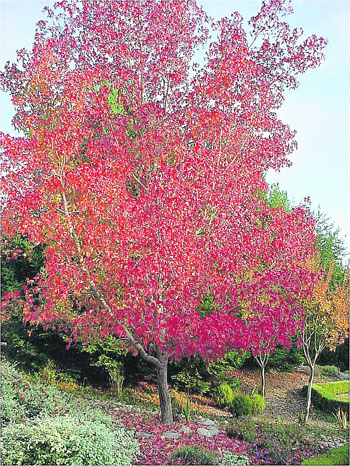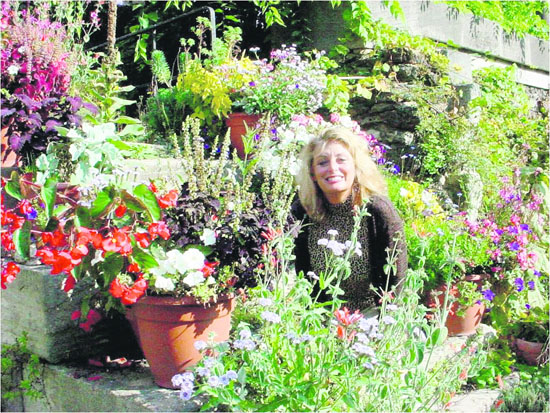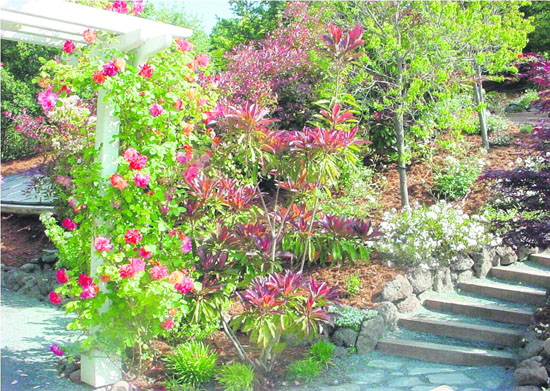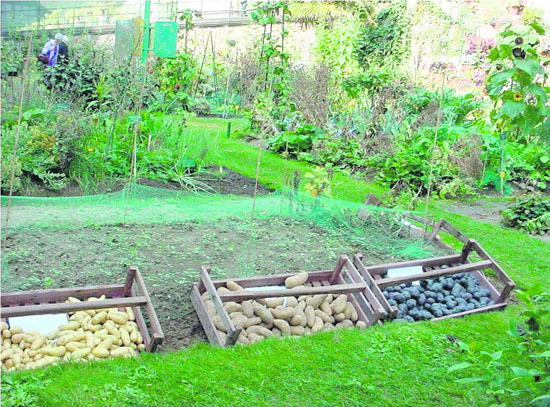| | Published October 1st, 2008
| "Autumn is a second spring when every leaf's a flower." --Albert Camus
| | By Cynthia Brian |  | | The colors of fall Photo Cynthia Brian
|
Last year at this time I was exploring glorious gardens in Paris, France. The weather was balmy, the smell of fall filled the air. Strolling through an organic vegetable patch, I was thrilled by the profusion of newly harvested purple potatoes and the array of brightly hued foliage. Despite the beauty of the City of Lights, I couldn't wait to return to Lamorinda to watch the changing of the leaves and start digging in my dirt to harvest my cornucopia of root vegetables, gourds and pumpkins.
 Autumn squash provide entertainment for the entire family. I usually hollow out a variety of white, blue, and peach colored pumpkins, place four inch pots of frilly kale, ornamental cabbage, or fall perennials inside as a front porch display of blazing accent. The squishy flesh and dried seeds offer a tasty treat for my chickens. As All Hallows Eve approaches, I remove the potted plants, carve creepy creatures into the gourds, insert scented candles and watch these natural vessels metamorphose into scary Jack O'Lanterns that delight the kids. With candle lit pumpkins illuminating driveways and sidewalks, the flickering of flames is part of the autumn panorama, and sometimes it's a haunting scene.
Autumn squash provide entertainment for the entire family. I usually hollow out a variety of white, blue, and peach colored pumpkins, place four inch pots of frilly kale, ornamental cabbage, or fall perennials inside as a front porch display of blazing accent. The squishy flesh and dried seeds offer a tasty treat for my chickens. As All Hallows Eve approaches, I remove the potted plants, carve creepy creatures into the gourds, insert scented candles and watch these natural vessels metamorphose into scary Jack O'Lanterns that delight the kids. With candle lit pumpkins illuminating driveways and sidewalks, the flickering of flames is part of the autumn panorama, and sometimes it's a haunting scene.
 For the past several Halloween's, I have donned the same costume. Actually it's not a costume, but well-worn turnouts, boots, and a fire helmet that belong to my fire fighting family. They smell strongly of smoke and soot and charred landscapes, which persuaded me to write this addendum to my autumn article.
For the past several Halloween's, I have donned the same costume. Actually it's not a costume, but well-worn turnouts, boots, and a fire helmet that belong to my fire fighting family. They smell strongly of smoke and soot and charred landscapes, which persuaded me to write this addendum to my autumn article.
 Fires have raged throughout California in the month of October in recent years. When a wildfire comes through your bucolic neighborhood, could your home survive on its own? Do you have a fire safe garden?
Fires have raged throughout California in the month of October in recent years. When a wildfire comes through your bucolic neighborhood, could your home survive on its own? Do you have a fire safe garden?
 Firescaping is landscape design that reduces house and property vulnerability to fires. The goal is to enhance your property while developing a design with choice of planting options that offer the best protection. Since October is a great time to plant and landscape, why not incorporate vegetation that makes significant contribution to wildfire survival?
Firescaping is landscape design that reduces house and property vulnerability to fires. The goal is to enhance your property while developing a design with choice of planting options that offer the best protection. Since October is a great time to plant and landscape, why not incorporate vegetation that makes significant contribution to wildfire survival?
 With firescaping, plant selection is primarily determined by the plant's ability to reduce the fire threat. Vegetative fuel flame lengths can exceed 100 feet and the radiated heat can ignite combustible materials from 100 feet or more. Add a wind factor, and live fire brands carry for several miles.
With firescaping, plant selection is primarily determined by the plant's ability to reduce the fire threat. Vegetative fuel flame lengths can exceed 100 feet and the radiated heat can ignite combustible materials from 100 feet or more. Add a wind factor, and live fire brands carry for several miles.
 Did you know that firefighters call junipers the gasoline plant? Evergreens, conifers, junipers, and other broadleaf trees and plants contain oils, resins, and waxes that burn at a high intensity. Ornamental grasses and berries are also highly flammable which make all of these poor choices for landscaping in residential areas.
Did you know that firefighters call junipers the gasoline plant? Evergreens, conifers, junipers, and other broadleaf trees and plants contain oils, resins, and waxes that burn at a high intensity. Ornamental grasses and berries are also highly flammable which make all of these poor choices for landscaping in residential areas.
 So what are the fire smart ideas? Deciduous trees are generally more fire resistant because of higher moisture content when in leaf and lower fuel volume when dormant. At maturity, trees can be very tall, so remember to factor their mature size into your overall design and keep their branches a minimum of 10 feet from any chimneys. Rocks, bricks, boulders, and fences constructed of non-flammable materials are fire retardant elements in a garden. Water features including ponds, pools, fountains, even dry creek beds are fuel breaks as are healthy green lawns. It may be tempting to leave your garden bare, especially in these times of water rationing, however, it is not recommended as soil erosion may occur.
So what are the fire smart ideas? Deciduous trees are generally more fire resistant because of higher moisture content when in leaf and lower fuel volume when dormant. At maturity, trees can be very tall, so remember to factor their mature size into your overall design and keep their branches a minimum of 10 feet from any chimneys. Rocks, bricks, boulders, and fences constructed of non-flammable materials are fire retardant elements in a garden. Water features including ponds, pools, fountains, even dry creek beds are fuel breaks as are healthy green lawns. It may be tempting to leave your garden bare, especially in these times of water rationing, however, it is not recommended as soil erosion may occur.
 Within 30 feet of your home, plant low growing, non-woody deciduous plants in addition to well irrigated perennials. If you are cutting down on turf grass, try using clover, groundcovers, and conservation grasses that you are willing to keep green during fire season. Leave spaces between the plants and express the natural beauty of the surroundings. When planting a new garden use fire-resistant materials for a fire safe environment that will enchant and protect your family for years to come.
Within 30 feet of your home, plant low growing, non-woody deciduous plants in addition to well irrigated perennials. If you are cutting down on turf grass, try using clover, groundcovers, and conservation grasses that you are willing to keep green during fire season. Leave spaces between the plants and express the natural beauty of the surroundings. When planting a new garden use fire-resistant materials for a fire safe environment that will enchant and protect your family for years to come.

|
 | | Cynthia Brian
|  | | A sunny day in the garden Photo Cynthia Brian
| “The difference between a good life and a bad life is how well you walk through the fire.” Carl Jung
|
CYNTHIA BRIAN’S FIRE WISE PLANT LIST
Although there are no fireproof plants, here is an abbreviated list of fire resistant plants that may work well in your new or re-imagined garden. |
TREES
Maple,
Redbud
Beech
Citrus
Tulip
Magnolia
Olive
Chinese Pistache
Liquid Amber
Crape Myrtle
Pepper
Locust
Dogwood
Stone Fruit Trees
Coast Redwood
Oaks
Buckeye
White Alder |
SHRUBS and VINES
Buddelia
Datura
Cotoneaster
Privet
Oleander
Hawthorn
Rhododendron
Azalea
Yucca
Periwinkle
Potato Vine
Star Jasmine
SUCCULENTS and
GROUND COVERS
Iceplant
Aptenia
Hen and Chicks |
Sedum
Yarrow
Ajuga
Litriope
Mock Strawberry
Vinca Minor
PERRENIALS
Iris
Lantana
Lavender
Society Garlic
Bird of Paradise
Lilies
Fuchsia
Geranium
Coreopsis
Coral Bells
Lamb’s Ear
Calla |
|
 Besides being aware of the danger of fires and reducing the amount of flammable plant specimens in your garden, autumn is the opportune time to consider replanting or replacing your lawn. By re-seeding, fertilizing, and aerating now, you’ll enjoy a healthy carpet of green which will require less water when springtime arrives. As the weather cools, the migration of birds increases. You’ll attract spectacular insect eating birds such as thrushes, thrashers, warblers and vireos when you make sure your fountains and birdbaths are filled with fresh water. Moving water is preferable as the birds hear the splashing from a distance and come to investigate. If you don’t want to invest in a recirculation pump for a pond or fountain, a shallow dish with pebbles at the bottom and clean water will entice fine feathered friends. Hummingbirds prefer misters, although they’ll hover over the spray from a fountain. Besides being aware of the danger of fires and reducing the amount of flammable plant specimens in your garden, autumn is the opportune time to consider replanting or replacing your lawn. By re-seeding, fertilizing, and aerating now, you’ll enjoy a healthy carpet of green which will require less water when springtime arrives. As the weather cools, the migration of birds increases. You’ll attract spectacular insect eating birds such as thrushes, thrashers, warblers and vireos when you make sure your fountains and birdbaths are filled with fresh water. Moving water is preferable as the birds hear the splashing from a distance and come to investigate. If you don’t want to invest in a recirculation pump for a pond or fountain, a shallow dish with pebbles at the bottom and clean water will entice fine feathered friends. Hummingbirds prefer misters, although they’ll hover over the spray from a fountain.
 Would it be autumn without the fire tinted falling leaves? The changing colors of the trees throughout our neighborhoods are candy to the senses, particularly pleasing are the Chinese pistache, liquid amber and Japanese maple. Gather branches or individual leaves for a creative centerpiece. Rake leaves into a pile to add to your compost pile, or use as mulch around frost tender plants. Most of all enjoy Nature’s display of flora sunsets. Would it be autumn without the fire tinted falling leaves? The changing colors of the trees throughout our neighborhoods are candy to the senses, particularly pleasing are the Chinese pistache, liquid amber and Japanese maple. Gather branches or individual leaves for a creative centerpiece. Rake leaves into a pile to add to your compost pile, or use as mulch around frost tender plants. Most of all enjoy Nature’s display of flora sunsets.
|
CYNTHIA’S DIGGING DEEP GARDENING GUIDE FOR OCTOBER
“Gardens are playgrounds for adults.” Cynthia Brian
|
 |
|
Photo Cynthia Brian
|
| “Gardens are playgrounds for adults.” Cynthia Brian
Fall is leisurely and lovely. The early days of October are warm and sunny, while later in the month the colors of the fall foliage are bursting with extraordinary exuberance. This is another busy gardening month. Our pumpkins are harvested now to become Jack O'Lanterns for little witches and goblins. The heat of the summer is past, the soil is still warm and it is time for landscaping to the maximum! There is plenty of work to be done!
• CLEAN up the annual flower beds and send to the compost pile.
Wash out pots and store in your shed.
• CUT off dead perennial blossoms and divide overgrown ones such as
agapanthus and columbine.
• FEED and fertilize newly planted winter perennials monthly.
• WEED the remnants of crab grass and other nuisances. Many weeds are
perennial plants which will spread their roots and their damage over the
winter months.
• FERTILZE houseplants and do not repot.
• ROSES need to be snipped continuously to keep them blooming until
pruning time in January.
• CONDITION soil by mulching with 3 inches of matter to protect plants
over the winter.
• CHOOSE fire safe plants when creating a new landscape. Fire safe plants
tend to be low growing, have a high moisture content and have stems and
leaves that are not resinous, oily, or waxy.
• RESEED lawns with cool season grasses while feeding existing lawns to
strengthen grass for earlier, stronger growth next spring.
• AERATE soil when the ground is moist to loosen compacted dirt.<
| | |

